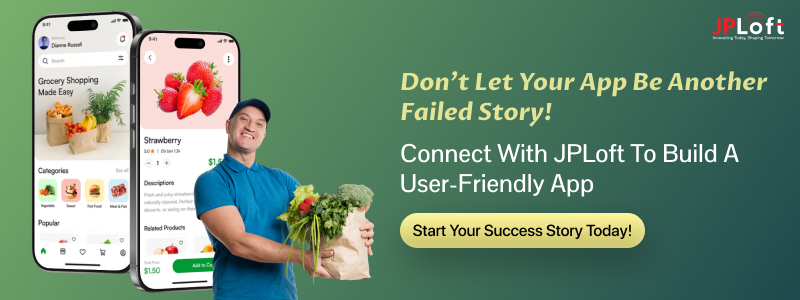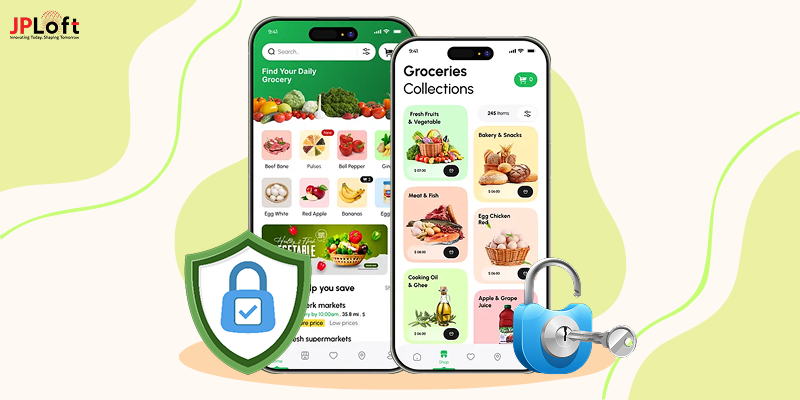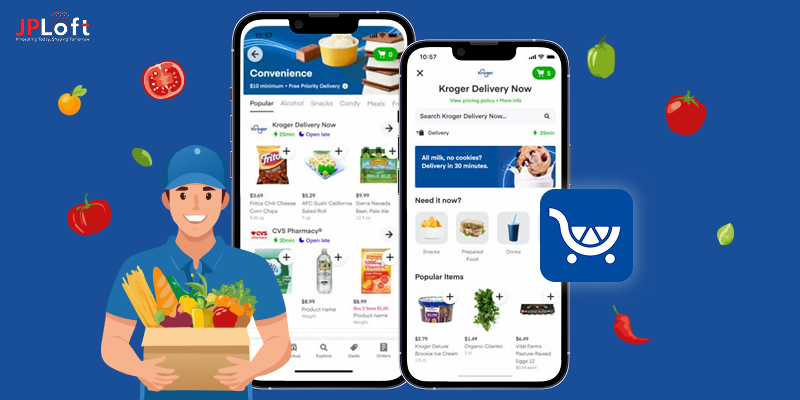Key Takeaways
Over 60% of grocery delivery startups fail, primarily due to unsustainable pricing models, poor logistics, and weak customer service.
Many apps collapse by scaling too quickly before validating their business model, resulting in high operational costs and low customer retention.
Discount wars and free deliveries generate short-term user growth but undermine profitability, leading to rapid failure.
Flawed technology infrastructure, frequent app crashes, and inadequate inventory create operational difficulty and degrade user experience.
Lack of differentiation in a crowded market dominated by giants like Amazon and Walmart causes many apps to struggle for visibility and loyalty.
The most successful apps combine scalable technology, efficient logistics, sustainable revenue streams, and a customer-centric approach.
By choosing JPLoft, you gain a strategic partner committed to your success with scalable solutions, robust features, and continuous support.
In the recent couple of years, grocery delivery apps have promised convenience at our fingertips; skip the lines, avoid traffic, and have fresh food brought straight to your door. Yet despite this booming demand for online services, many of these apps struggle or even get shut down!
So now the question arises: Why grocery delivery apps fail?
The reasons go far beyond high competition or lack of funding. From flawed logistics and inconsistent product quality to poor user experience and unsustainable business models, several critical issues can sink even the most well-funded platforms.
In this blog, we will unpack reasons why grocery delivery apps fail, the common pitfalls, and the underlying factors that contribute to their downfall. Whether you are a startup founder, investor, or already have a thriving grocery delivery app business, these challenges offer valuable insight into what it takes to succeed and why so many get it wrong.
Understanding the Grocery Delivery Apps and Its Market
Grocery delivery apps have transformed the way people shop by bringing essential goods directly to their doorstep. These apps act as a digital bridge between retailers and consumers, allowing users to browse products, compare prices, place orders, and schedule deliveries, all from the convenience of their smartphones.
These grocery delivery apps are designed to save time, reduce the hassle of in-store shopping, and offer added benefits such as discounts, subscription plans, and personalized recommendations. At their core, grocery delivery apps rely on the key stakeholders: customers who demand convenience, retailers or suppliers who provide the inventory, and delivery partners who ensure timely fulfillment.
Successful apps often integrate the best grocery delivery app features, such as real-time inventory tracking, multiple payment options, order scheduling, and customer support. Behind this seamless experience lies a complex ecosystem of logistics, technology, and operations, which, if not managed effectively, can quickly turn into key reasons for grocery delivery app failure.
Grocery Delivery App Market Statistics
Currently, the grocery delivery app market is witnessing robust growth, with the major expansion driven by convenience demands and increasing use of mobile and digital platforms worldwide. Here are the most recent market statistics of grocery delivery apps:
-
According to Verified Market Reports, the global market size for grocery delivery apps hit USD 4.3 billion in 2024, with forecasts suggesting a jump to USD 12.4 billion by 2033, reflecting a 12.5% CAGR from 2026 to 2033.
-
As Mordor Intelligence estimates, the global grocery delivery service market is valued at over USD 600 billion in 2025, with projections of exceeding USD 1.5 trillion by 2030, with a CAGR of 22%.
-
According to research by Verified Market Reports in 2022, approximately 30% of U.S. households used grocery delivery services.
-
Quick commerce (sub-30-minute fulfillment) is growing fastest, especially in dense urban markets, with a forecasted 29.3% CAGR through 2030, estimated by Mordor Intelligence.
-
According to Deliverect, over 1.5 billion people globally use online grocery delivery apps as of 2025, representing roughly 20% of the world's population.
-
As found in research by Statista, in the U.S., 67% of consumers shop for groceries online, with 40% making grocery orders weekly, marking a permanent shift in shopping behavior.
These numbers confirm that grocery delivery apps are no longer niche; they are core to consumer lifestyles and retail growth, driven by technology, speed, and convenience.
While the rise of grocery delivery apps highlights a booming market with growing consumer demand, not every platform manages to sustain this success. To understand the other side of the story, let's explore the key reasons why grocery delivery apps fail despite such high demand.
Why Grocery Delivery Apps Fail?
Grocery delivery apps have seen tremendous growth as consumer preferences shift toward convenience, but why do grocery delivery startup apps fail despite the booming market? Failures arise from varied operational, technological, financial, and strategic grocery delivery app challenges that, if not managed well, can doom even promising ventures.
Here are the major reasons why online grocery delivery apps fail, explained so that you don't make the same mistake with your business:
1. Overexpansion Without Validation
Many startups, like Webvan, rushed into multiple cities or regions without proving their business model in a single market. They invested heavily in warehouses, fleets, and infrastructure before securing a loyal customer base. This results in skyrocketing costs, low returns, and eventual shutdown.
Advice: Validate your model in one region before scaling. Growth should be gradual, not reckless.
2. Unsustainable Pricing and Discount Wars
Several grocery apps rely heavily on discounts to attract users. While this may generate short-term buzz, it erodes profitability. Companies like Kozmo offered free or ultra-cheap deliveries without sustainable grocery delivery app revenue streams, leading to financial collapse.
Advice: Focus on value-driven pricing and loyalty programs instead of endless discounts. Profitability matters more than vanity metrics.
3. Complex and Costly Logistics
Grocery delivery isn’t like regular e-commerce. Fresh produce, frozen goods, and perishable items demand specialized handling, cold storage, and speedy fulfillment. Many apps underestimate the complexity of last-mile delivery, leading to delays, spoilage, and customer dissatisfaction.
Advice: Invest in strong logistics, real-time tracking, and cold-chain infrastructure to handle perishables efficiently.
4. Poor Inventory Management
One of the key reasons for grocery delivery app failure is inaccurate inventory listings, where items shown as “in stock” but are unavailable frustrate customers. Frequent cancellations or substitutions break trust. Companies that fail to sync inventory between suppliers and apps lose credibility quickly.
Advice: Integrate real-time inventory tracking with suppliers and warehouses to ensure accuracy.
5. Lack of Differentiation
The grocery delivery space is crowded, with competitors ranging from small startups to giants like Amazon and Walmart. Apps that fail to offer unique value, whether in niche products (organic, local farms) or superior service (express delivery, personalized recommendations), struggle to stand out.
Advice: Define a clear USP (unique selling proposition). Competing only on price is a losing strategy.
6. High Operational Costs
Running a grocery delivery service requires warehouses, staff, delivery fleets, technology maintenance, and customer support. Without efficient systems, operational expenses quickly outpace revenue. One of the reasons why grocery delivery apps fail is because they exhaust investor money without achieving self-sustainability.
Advice: Use hybrid models (like dark stores, partnerships with local retailers) to reduce overhead and streamline operations. Partner with an experienced mobile app maintenance service provider.
7. Misreading Consumer Behaviour
Companies like Tesco’s Fresh & Easy grocery delivery startup app failure in the U.S. showed what happens when companies assume shopping habits are universal. They offered limited assortments and self-checkout-style stores, which didn’t resonate with American preferences.
Advice: Understand local culture, buying patterns, and product expectations before entering new markets.
8. Weak Technology Infrastructure
One of the causes why grocery delivery app fail is due to clunky interfaces, frequent crashes, or poor payment integration, which loses customers fast. A fragile tech foundation magnifies operational mistakes, making it impossible to scale smoothly as order volumes grow and customer expectations rise. Weak backend systems lead to order mismatches, late deliveries, and poor user experiences.
Advice: Invest in a robust, scalable mobile app tech stack that ensures smooth operations and a frictionless user experience.
9. Poor Last-Mile Delivery Execution
The “last mile” is the most expensive and crucial step. Inefficient routing, traffic delays, or a lack of reliable delivery partners result in late or missed deliveries. This frustrates customers, especially when groceries are time-sensitive.
Advice: Optimize delivery routes with AI, maintain well-trained delivery teams, and set realistic time promises. Hire an adequate AI app development company to get ideal results.
10. Lack of Profitability Focus
Some grocery delivery apps chase user acquisition at all costs, ignoring profitability. This works temporarily when investor funding flows in, but as soon as funding dries up, the unsustainable model collapses. Ignoring the bottom line creates a growth bubble that eventually bursts when funding slows, leaving the company unable to sustain itself in the long run.
Advice: Building revenue streams at an early stage, like delivery fees, subscription models, or partnerships, can create sustainable growth.
11. Inconsistent Product Quality
One of the top reasons why a grocery delivery apps fail: poor product quality. If customers receive wilted vegetables, stale bread, or near-expiry products, they will not return. Several failed apps underestimated quality control, leading to high churn rates. In groceries, the quality of an item isn’t just a feature, it’s the brand’s reputation.
Advice: Prioritize supplier vetting, strict quality checks, and feedback-driven improvement loops.
12. Ineffective Marketing and Branding
Some apps fail to communicate their value proposition effectively. Without strong marketing, even good services remain unnoticed. Others spend recklessly on ads without building long-term brand loyalty. Customers often choose apps based on trust, visibility, and brand recall rather than product uniqueness.
Advice: Use data-driven marketing, customer referral programs, and community engagement to build trust and awareness sustainably.
13. Intense Competition
The development of Instacart, Amazon Fresh, and Walmart-like giants has drastically raised the bar, creating another factor in why online grocery delivery apps fail. Smaller apps without niche markets or financial backing often get crushed in direct competition. Surviving in this space requires resources and strategic positioning because consumers will quickly migrate to platforms offering better value.
Advice: Compete smart, not big. Focus on specialized markets (organic, hyperlocal, and ethnic foods) where giants aren’t dominant.
14. Poor Customer Support
Customers expect quick resolution of issues like late deliveries, missing items, or payment failures. Apps that lack responsive customer service lose users rapidly. Without empathetic and responsive support, even a single bad experience can push customers toward competitors, as grocery is a high-frequency and trust-driven purchase category.
Advice: Build strong customer support systems, with chatbots for speed and human agents for complex cases. Use a universal mobile app design for easy understanding by customers of any age and region.
15. Failure to Adapt to Market Changes
Markets evolve rapidly, like pandemics, inflation, or lifestyle changes, which alter consumer behavior. Companies that fail to pivot their strategies (e.g., offering contactless delivery during COVID-19) risk obsolescence. Companies must anticipate disruptions and pivot quickly to remain relevant in dynamic market conditions.
Advice: Stay agile. Continuously track new grocery delivery app trends and adapt models to align with customer expectations and external factors.
Understanding how grocery delivery apps fail is a mix of unsustainable pricing, poor logistics, weak technology, and mismanagement of customer expectations. Established giants remain powerful rivals, but startups that validate demand, optimize operations, build robust tech, and craft compelling customer engagement strategies can carve sustainable market positions.
Understanding the common reasons behind grocery delivery startup failure sets the stage, the picture becomes clearer when we look at real-world examples. Let’s examine case studies of failed grocery delivery startups and uncover the lessons they leave behind.
Case Studies: What Grocery Delivery App Failures Can Teach You
The grocery delivery sector has seen a surge in interest worldwide, but not all players have been able to survive. Several once-promising ventures collapsed under financial pressure, operational inefficiencies, or flawed strategies.
Here are some notable grocery delivery app failure case studies, along with their mistakes and their lessons for other upcoming/existing delivery businesses to avoid similar pitfalls:
1] WebVan (U.S.)
Mistakes:
-
Overexpansion with huge investments in automated warehouses and delivery trucks occurred before the customer base was sufficient. High operational costs far outpaced revenue, creating unsustainable losses (~$800 million).
-
Overestimation of customer willingness to switch from physical to online grocery shopping.
-
Trying to be the "winner-takes-all" in multiple markets simultaneously.
-
A complex operational model combining warehousing and last-mile delivery under one roof is cost-prohibitive.
Lessons To Learn:
-
Avoid scaling infrastructure too fast before validating strong, sustainable demand, and focus on gradual expansion aligned with customer growth.
-
Balance CapEx with customer acquisition to maintain cash flow.
-
Adapt to existing customer habits and create an app with simple, scalable models focusing on a niche first, rather than forcing radical change.
-
Separate warehousing and delivery to control costs.
2] HomeGrocer (U.S.)
Mistakes:
-
Heavy fixed overhead with warehouses and delivery infrastructure before scaling the customer base.
-
Poor market timing: consumer readiness for online groceries was low in the late 1990s.
-
High delivery costs and poor unit economics led to unsustainable losses.
Lessons To Learn:
-
Match infrastructure investment to validated demand.
-
Use leaner tech and third-party logistics to reduce fixed costs early on.
3] Streamline (U.S.)
Mistakes:
-
Overambitious geographic expansion without localized marketing strategies.
-
Failure to optimize inventory leads to frequent stockouts.
-
Poor user experience in the app and website slowed user acquisition.
Lessons To Learn:
-
Focus on gradual market expansion with localized strategies.
-
Invest in inventory and user experience management.
-
Prioritize the customer feedback loop to refine the product.
4] Kozmo (U.S.)
Mistakes:
-
Attempted ultra-fast deliveries (1-hour) without a scalable delivery network.
-
Over-invested heavily in infrastructure and marketing without sustainable returns.
-
Did not achieve the volume needed for profitable operations, burned through funding too quickly, and lacked a sustainable model.
-
Built for urban markets, but couldn’t solve profitability with the extremely fast delivery promise.
Lessons To Learn:
-
Validate speed vs. cost trade-offs carefully before scaling.
-
Focus on operational scalability and unit economics before aggressive marketing.
-
Build an AI app for a sustainable economy and a clear path to profitability.
-
Avoid overhyped promises without an operational backbone.
5] FreshDirect (Initial Struggles, U.S.)
Mistakes:
-
Early issues with delays and order inaccuracies.
-
High delivery costs made profitability challenging initially.
-
Limited geographic coverage slowed customer acquisition.
Lessons To Learn:
-
Prioritize accurate fulfillment and delivery efficiency.
-
Expand delivery zones cautiously, based on operational capacity.
-
Continuous process improvement can enable turnaround success.
6] Peapod (U.S.)
Mistakes:
-
Initially struggled with limited product assortments and slow deliveries.
-
Customer dissatisfaction due to a lack of product variety and app limitations.
-
Early tech platforms were cumbersome and not mobile-optimized.
Lessons To Learn:
-
Constantly upgrade tech platforms and apps for usability.
-
Expand product ranges based on customer insights.
-
Improve delivery infrastructure for faster order fulfillment.
7] Safeway Express (U.S.)
Mistakes:
-
A large brick-and-mortar retailer was quick to adapt but failed initially in its digital strategy.
-
Neglected mobile app usability and marketing, losing customers to agile startups.
-
Frequent delivery delays, missing items, and poor substitution choices led to customer frustration and loss of loyalty.
-
Customer service issues, including a lack of timely communication and refund delays, further damaged brand trust.
Lessons To Learn:
-
Legacy retailers must prioritize digital UX and marketing investment to compete.
-
Customer-centric grocery delivery app design is crucial for engagement.
-
Strong operational coordination between order fulfillment and delivery partners is essential for reliability and customer satisfaction.
Most of these grocery delivery app failure results from overexpansion, unsustainable pricing models, weak logistics, and a lack of differentiation. Companies can avoid these pitfalls by focusing on sustainable growth, customer trust, efficient supply chains, smart monetization strategies, and hiring an expert dedicated on-demand app development company.
How Can JPLoft Help You in Creating a Successful Grocery Delivery App?
Building a grocery delivery app that thrives in today’s competitive market requires more than just coding. It demands a strategic blend of technology, design, and operational excellence. This is where JPLoft can be your trusted partner.
At JPLoft, we specialize in crafting scalable, feature-rich, and user-friendly grocery delivery apps tailored to your business goals. Our team understands the unique challenges of the grocery sector: real-time inventory management, smooth payment integration, route optimization, and customer engagement tools.
JPLoft, a dedicated grocery delivery app development company, focuses on innovation and sustainability. We build apps with advanced features like AI-powered product recommendations, multiple delivery models (hyperlocal, marketplace, or inventory-based), and robust analytics dashboards to help you make data-driven decisions.
Whether you are a startup entering the grocery delivery market or an established retailer looking to expand digitally, our experts provide end-to-end solutions, from ideation and UI/UX design to development, testing, deployment, and ongoing support.
With JPLoft, you don’t just get an app, you get a long-term partner committed to your success in the evolving grocery delivery industry.
Conclusion
The grocery delivery market holds enormous potential, but success is far from guaranteed. Knowing why grocery delivery apps fail is because they underestimate the operational, technological, and financial complexities involved. From poor logistics and weak customer support to unsustainable pricing strategies and a lack of differentiation, there are many pitfalls.
However, these challenges are not inescapable. By carefully validating the business model, prioritizing customer satisfaction, investing in reliable technology, and maintaining a clear focus on profitability, companies can transform these obstacles into opportunities. Agility, innovation, and attention to detail will separate thriving grocery delivery apps from those that collapse under pressure.
The lessons from past failures make it clear: survival in this competitive space requires more than just an app, it demands a holistic strategy that balances convenience with sustainability. By examining how do grocery delivery apps fail, startups and established retailers can avoid repeating mistakes, validate demand carefully, and focus on building resilient, profitable models that last.
FAQs
Grocery delivery apps often fail due to weak logistics, poor customer service, unsustainable pricing, lack of differentiation, and overexpansion. Without a scalable model and strong customer trust, even well-funded apps struggle to survive long-term in this competitive market.
Technology is critical, as it powers inventory tracking, delivery optimization, payments, and customer experience. Weak infrastructure leads to glitches, delays, and inefficiency. A robust, scalable platform ensures seamless operations, real-time updates, and reliability, making technology the backbone of a successful grocery delivery business.
Many startups chase rapid growth by offering deep discounts and free deliveries. While this attracts customers initially, ignoring profitability leads to unsustainable models. Long-term success requires balancing convenience with healthy margins through efficient logistics, smart monetization, and strong operational control.
Yes. Without effective marketing and strong branding, even a great app struggles to attract or retain customers. Grocery products are often commoditized, so building trust, visibility, and recall through impactful campaigns is essential for long-term growth and customer engagement.
The biggest lessons are to avoid scaling too fast, invest in logistics, focus on customer experience, ensure profitability, and adapt quickly to market shifts. Successful grocery delivery apps combine innovation with sustainability, creating trust and consistent value for their customers.













Share this blog